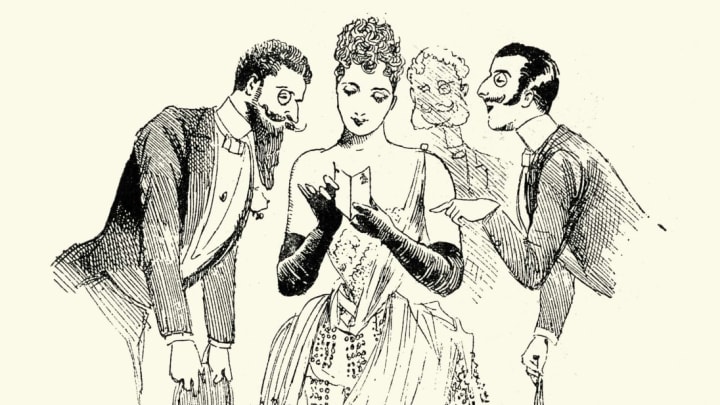During the Victorian era, well-to-do families delighted in hosting extravagant balls, which were attended by other well-to-do families in the area. While these occasions were highly anticipated opportunities for young ladies to mingle with all the eligible bachelors, letting loose on the dance floor was not loose in any way.
For one, the dances themselves were extremely specific—waltzes, polkas, quadrilles, and other numbers whose steps and formations had been practiced before. And thanks to dance cards, the process of choosing whom to dance with was rather choreographed, too. As HowStuffWorks explains, each woman received a card on which to write the names of her dance partners in order. Not only did it place the responsibility of asking for dances squarely on the shoulders of the men, but it also prevented partygoers from spending the end of every dance trying to figure out who their next partner would be.
Card designs varied widely from ball to ball. Some hosts printed the lineup of dance numbers right on them—so ladies knew what they’d be dancing with each man—while others only included slots for jotting down names. Your card might look like a plain old card, or it might be shaped like a musical instrument, a fan, or some other whimsical object. It could be embossed with gold, embellished with bows, or illustrated with flowers.

All design features aside, your card would likely have a dainty pencil hanging off it. “A pencil should be attached by a ribbon,” The Ball-Room Guide advised in 1874. “But gentlemen should make a mem. [sic] always to provide themselves with a small gold or silver pencil-case when going to a ball, so that they may be prepared to write down engagements.”
Young ladies in high demand (which was sometimes less about your waltzing skills and more about your marriage potential) may even end up turning away prospective partners with a polite “My dance card is full.” It was an effective way to let someone down easy, since it implied that you would’ve been happy to accept their invitation otherwise.

Though dance cards eventually fell out of fashion in the 20th century, saying “My dance card is full” has lingered as an alternative to “I would if I could, but I can’t.” If you’re wondering whether girls ever pretended their dance cards were full to avoid spinning around the room with some undesirable suitor, ask yourself this: Have you ever fibbed to get out of a date?
